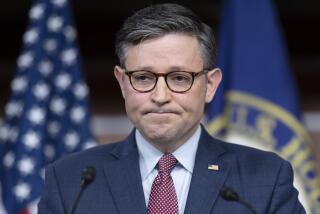U.S. Aid on Early Retirees’ Health Benefits Pledged
- Share via
WASHINGTON — The Clinton Administration is seeking to win business and labor support for its health reform plan by offering a multibillion-dollar subsidy for companies now paying health benefits for workers who retired early, as well as other concessions, sources said Wednesday.
The Administration has decided to propose that the federal government pay 80% of the cost of health benefits for workers who retired between 55 and the age of eligibility for Medicare, which is 65, business lobbyists were told Wednesday at a meeting with Administration officials.
This would cost an estimated $4 billion total by the year 2000 and would be a major boon for the auto and steel industries, telephone companies and other businesses with an aging work force. State and local governments also would benefit as the federal subsidy pool takes over some of their financial burden for former workers now in retirement.
The subsidy for companies now paying the health care bills for early retirees was included in the draft of the Clinton plan leaked to the press last week but the section was marked “under review,” making it the last major part of the plan to get final White House approval.
The employer, whether a company or state or local government, would pay 20% of the cost of health benefits for retired people too young for Medicare.
There are 1.2 million retirees between 55 and 65 whose benefit obligations would be shifted from their former employers to the federal government, said William Custer, research director for the Employee Benefit Research Institute. Traditional manufacturing industries and utilities would gain particular financial help, he noted.
“Retiree health benefits have been under assault, being cut back or eliminated,” said Alan Reuther, legislative director of the United Auto Workers, which welcomed the Administration proposal.
“This will level the playing field for companies that have been in business for a long time and have many retirees” but that must compete with firms with younger workers and few retirees, he said.
The Clinton health plan would provide universal health coverage for all Americans for the first time. After it takes effect, workers who retire between 55 and 65 will be responsible for the cost of health insurance premiums for themselves and their families, although some employers might choose to pay a share of the premiums and the government may contribute some amount for lower-income retirees. At age 65, all Americans are eligible for Medicare.
Workers in manufacturing companies and in state governments traditionally have had employer-paid health insurance when they retired early. For this group, the new system would continue their special benefit but shift the cost from their employer to the federal government.
The plan, if adopted by Congress, would provide a financial windfall to the Big Three domestic auto makers--General Motors, Ford and Chrysler--and to other firms in manufacturing. The Administration wants to recapture some of this money and is considering various techniques, such as a onetime tax or other charge for those companies.
The Administration also promised other concessions Wednesday as part of its effort to secure business support for Clinton’s proposal to impose mandatory insurance coverage on all employers.
The original plan called for companies to be allowed to operate their own health benefit plans independent of the alliances only if they have at least 5,000 workers and pay a special 1% fee.
Instead, officials told business lobbyists that the levy will be lower, ranging from 0.2% to 0.7%.
The Administration also has retreated from a provision of the draft plan that would have allowed the government to impose price controls on breakthrough drugs. Pharmaceutical companies argued that this would have inhibited research and development.
Also Wednesday, Administration officials took steps to ease health care industry concerns that any mergers, joint purchasing agreements and other cost-cutting steps would lead to government antitrust charges. Federal agencies issued unprecedented guidelines outlining what would be acceptable. Normally, officials wait for a particular action to occur before deciding whether it violates antitrust rules.
With First Lady Hillary Rodham Clinton praising the actions as “pro-competition, pro-collaboration and pro-consumer,” the Justice Department and Federal Trade Commission also committed themselves to answering within 90 days any health business requests for guidance on joint ventures and exchange of information.
The guidelines, as detailed by FTC Chairwoman Janet D. Steiger and Anne K. Bingaman, assistant attorney general for antitrust, were contained in six policy statements that sketched “safety zones” for conduct the two agencies would not challenge.
The areas included hospital mergers and joint ventures involving high technology or other expensive medical equipment. They also would allow physicians to provide information to purchasers of health care services, hospitals to take part in exchanging price and cost information, joint purchasing arrangements among health care providers and joint ventures by physician networks.
As an example of acceptable conduct in the safety zones, the antitrust agencies said they would not challenge a merger between two hospitals if one is so small that during the last three years it has had an average of fewer than 100 beds and fewer than 40 patients daily.
The guidelines drew praise from California hospitals. “I don’t know any hospital that isn’t discussing an affiliation or an alliance,” said David Langness, spokesman for the Hospital Council of Southern California.
In Southern California, hospitals are suffering from a glut of beds. More than half lost money last year, the council said.
Times staff writers Ronald J. Ostrow and Paul Richter in Washington and David Olmos in Los Angeles contributed to this story.
More to Read
Get the L.A. Times Politics newsletter
Deeply reported insights into legislation, politics and policy from Sacramento, Washington and beyond. In your inbox twice per week.
You may occasionally receive promotional content from the Los Angeles Times.










